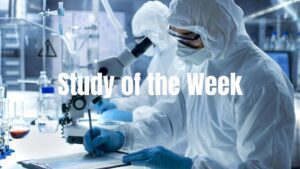Welcome to Study of the Week from Patient Worthy. In this segment, we select a study we posted about from the previous week that we think is of particular interest or importance and go more in-depth. In this story we will talk about the details of the study and explain why it’s important, who will be impacted, and more.
If you read our short form research stories and find yourself wanting to learn more, you’ve come to the right place.

This week’s study is…
Structure and function of an effector domain in antiviral factors and tumor suppressors SAMD9 and SAMD9L
We previously published about this research in a story titled “Research Identifies How Gene Mechanisms Influence Pediatric MDS” which can be found here. The study was originally published in the journal Proceedings of the Natural Academy of Sciences of the United States of America. You can view the abstract of the study here.
This research team was affiliated with UT Health San Antonio.
What Happened?
The origins of cancer in children, particularly rare cancers such as myelodysplastic syndromes (MDS) are varied and not often well known. Prior studies of this disease have found that genetic mutations affecting the genes SAMD9 and SAMD9L are present in around eight percent of pediatric cases. While this may seem like a small percentage, this still makes these mutations the most common known cause of the disease in children. However, the mechanism behind how mutations in these genes promote myelodysplastic syndromes was not known. This study sought to understand how these mutations were connected to the appearance of the rare blood cancer.
These genes typically have an antiviral and tumor suppressor role; as a result, these genes are not activated unless an infection is present. However, when mutated, these genes are activated all of the time. This can lead to myelodysplastic syndromes as well as other diseases. The team identified an effector domain for the genes that binds to double-stranded nucleic acids (dsNA). From here, the researchers were able to determine the crystal structure of this domain in complex with DNA.
The antiviral and antitumor effects of these genes depend on this binding mechanism. The scientists found that the mutations disrupt protein synthesis in the cells, which triggers a stress response. This disruption and stress response is a possible explanation for the underdeveloped immune system found in many of these patients that have these mutations. This also backs up some findings in other recent studies that have suggested protein synthesis playing a role.
The researchers found that the SAMD9 and SAMD9L proteins have specific regions that are vital for their function. The region facilitates the toxic function by binding to nucleic acids. If the scientists deactivated this region, then they were able to halt the toxic effects of the mutated proteins.
About Myelodysplastic Syndromes
Myelodysplastic syndromes are a type of blood cancer in which developing blood cells remain immature and fail to transform into usable blood cells. Risk factors for this disease include exposure to radiation, chemotherapy, benzene, xylene, and Agent Orange. Family history is also a risk, as are certain genetic disorders such as Down syndrome. The disease is very rare in children. It represents under five percent of pediatric blood cancers and is estimated to affect only about one in a million newborns annually. In an individual case, it is rare for the direct cause to be identified. Myelodysplastic syndromes rarely present with symptoms initially, but it can eventually present with anemia, neutropenia, thrombocytopenia, cell abnormalities, chromosome abnormalities, enlarged spleen and/or liver, easy bleeding and bruising, and infections. The disease also has the potential to evolve into acute myeloid leukemia. Treatment may include bone marrow transplant, stem cell transplant, blood products, and certain chemotherapy agents. Outcomes in this disease range widely and can depend on a number of factors. To learn more about myelodysplastic syndromes, click here.
Why Does it Matter?
These study findings are giving the scientific community critical information that will greatly improve the understanding of myelodysplastic syndromes and how it can appear in children. In addition, the study identified a possible treatment approach. The researchers were able to acquire the crystal structure of the functional regions identified in the genes:
“Since we have the structure of that region, and we know its function, we fully believe we have identified a key therapeutic target for pediatric myelodysplastic syndromes derived from SAMD9 and SAMD9L mutations.” – Yan Xiang, Ph.D
The ultimate goal from these findings is to begin the development of a therapeutic molecule that will target this critical region. Currently, the only real treatment for pediatric myelodysplastic syndromes is bone marrow transplant, which is a risky approach that can be very taxing to the patient. The possibility of having an alternative treatment will be very welcome to these patients and their families. Further research will begin focusing on this task.


